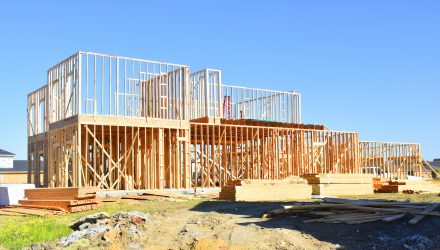While stocks and index ETFs declined for a second consecutive day on Tuesday, one of the biggest surprises was from housing market data.
Housing starts plummeted 9.5% to a seasonally adjusted annual rate of 1.569 million units last month, according to data from the Commerce Department on Tuesday. Economists polled by Dow Jones had projected starts to decline to a rate of 1.7 million units in April.
The news rocked the iShares DJ US Home ETF (ITB), which fell 3.75% Tuesday, while the SPDR S&P Homebuilders ETF (XHB) lost 2.87%.
Despite the losses in the homebuilder sector, Home Depot posted explosive earnings, as consumers continue to flock to the home supply superstore to complete home renovations and improvements during the pandemic.
Home Depot stock climbed over 2% in premarket trading but has traded in the red since the market opened. Overall, the company’s stock has gained over 20% this year, giving it a market value of $344 billion as of Monday’s close, and helping to spur ETFs like the VanEck Vectors Retail ETF (RTH) higher.
“Fiscal 2021 is off to a strong start as we continue to build on the momentum from our strategic investments and effectively manage the unprecedented demand for home improvement projects,” CEO Craig Menear said in a statement.
“The current shortage of new housing clearly is helping to drive improvements in the home values, which is a good thing for spending in the home,” Menear said on the conference call as well.
Of course, some of that spike in consumer spending could be related to the higher prices of commodities such as lumber, where the price for a sheet of oriented strand board lumber has quadrupled over the last year, according to executives.
“We don’t see a lot of capacity coming online, so we’re probably not going to see a lot of finished lumber product in distribution, so as soon as that product hits our stores, it sells,” Menear said.
So far, the price hikes are isolated mostly to specific industries. Lumber this month hit an all-time high of $1,686 per thousand board feet, having surged by 406 percent from the $333 per thousand board feet it was trading at the same time a year ago, and by 438 percent from its price five years ago.
Lumber is so difficult to find in Canada, who supplies much of America’s wood, that even those loggers who would like more work are struggling to find the resources to gather scarce lumber.
“I can’t find a log trailer for sale anywhere. I’ve got two trucks I want to get hauling, and I can’t find a trailer anywhere. You talk to the manufacturer and they say there’s a year-and-a-half wait,” logger Chace Barbe said. “And you can’t find log truck drivers. Everyone who can and wants to drive a log truck is already driving a log truck.”
Home prices have been climbing for quite some time, something that has only been exacerbated by the pandemic, but with the lumber shortage and rising commodity prices in general, there is now concern that costs could damage the homebuilding sector, and potentially homebuilder ETFs.
“The fact is if this continues, you will see the homebuilding sector slow down and grind to a halt,” said Jerry Howard, CEO of the National Association of Homebuilders, who said housing is often a leading indicator of economic health. “This problem with lumber and other building material costs is sort of setting another potential perfect storm for housing to lead us into a recession.”
While some analysts point to hot inflation as the source of the commodity prices, other traders and experts disagree.
“Covid added additional fuel to an already existing inferno,” said Thom Rafferty, a commodity trader at Millbrook Lumber Inc. outside Boston. “It has nothing to do with inflation.”
Finally, climbing prices also could mean even tighter supply, in an already limited market, for would-be homebuyers.
“Some builders are slowing sales to manage their own supply chains, which means growing affordability challenges for a market in critical need of more inventory,” said Robert Dietz, NAHB’s chief economist. “Homebuyers should expect rising prices throughout 2021 as the cost of materials, land and labor continue to rise.”
For more market trends, visit ETF Trends.
